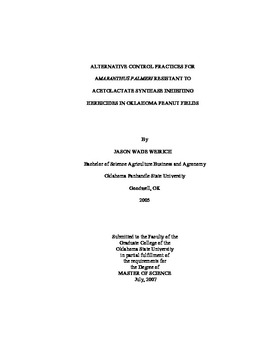| dc.description.abstract | Palmer amaranth populations across western Oklahoma are developing resistance to acetolactate synthase (ALS) inhibiting herbicides. Palmer amaranth is one of the most troublesome weeds in Oklahoma peanut production today due to its rapid growth rate, high competitiveness, long germination period, and high seed production. Prior to it developing resistance to the ALS inhibiting herbicides and the adoption of no-till production systems, pendimethalin EC (the emulsifiable concentrate formulation) applied PPI and/or imazapic applied POST were commonly used for its control. With these issues in mind, on-farm and research station based experiments in southwest Oklahoma were established to evaluate ALS resistant pigweed control, in no-till and strip-till systems with various levels of herbicides imposed. Herbicide treatments included pendimethalin EC (1.1 kg ai/ha) or pendimethalin PE (the polymer encapsulated formulation) (1.1 kg ai/ha) applied PRE in the no-till plots or, PPI within the tilled zone of the strip-till unit which were applied alone or with pendimethalin PE (1.1 kg ai/ha), S-metolachlor (1.4 kg ai/ha), flumioxazin (0.045 kg ai/ha), diclosulam (0.012 kg ai/ha), dimethenamid-P (2.1 kg ai/ha), or split applications of S-metolachlor (1.4 kg/ha). Pendimethalin EC and PE incorporation was accomplished with Lilliston rolling baskets in the strip-till plots and irrigation in the no-till plots. Only the herbicide treatment effect was significant for Palmer amaranth control and peanut yield. Pendimethalin EC (1.1 kg/ha) controlled Palmer amaranth 52% compared to 28% with pendimethalin PE (1.1 kg/ha), 53 d after treatment (DAT) at Beckham and Caddo counties respectively. PRE applications of diclosulam (0.012 kg/ha), S-metolachlor (1.4 kg/ha), dimethenamid-P (2.1 kg/ha), and pendimethalin PE (1.1 kg/ha) controlled Palmer amaranth at least 81% 53 DAT. At Caddo County pendimethalin EC (1.1 kg/ha) followed by split applications of S-metolachlor (1.4 kg/ha), applied PRE and 3 wk after planting (WAP), increased yield 287 kg/ha over pendimethalin EC (1.1 kg/ha) applied alone. Pendimethalin EC (1.1 kg/ha) followed by dimethenamid-P (2.1 kg/ha) increased yield by 214 kg/ha over the untreated check at Beckham County. Amaranthus is the genus of the pigweed family. The word is derived from the Greek word, amarantus, which means "everlasting". Research has shown significant yield reduction from the competition of the Amaranthus sp. in numerous crops. This experiment was conducted to evaluate peanut injury and efficacy of POST herbicide applications. In 2005, all plots received pendimethalin EC (the emulisifiable concentrate formulation) (1.1 kg/ha) PPI followed by (fb) paraquat (0.28, 0.42, 0.56, and 0.28 fb 0.28 kg ai/ha), lactofen (0.28, 0.56, and 0.28 fb 0.28 kg ai/ha), bentazon (0.56 kg ai/ha), or aciflourfen (0.28, 0.32 and 0.14 fb 0.14 kg ai/ha) applied POST. Lactofen (0.28 kg/ha) controlled small (less than 10-cm tall) pigweeds at least 94%, provided inadequate control of larger weeds, and caused minimal injury to the crop. Tank mixing bentazon (0.56 kg/ha) with paraquat (0.56 kg/ha) increased crop safety over paraquat (0.56 kg/ha) alone, but also reduced pigweed control from 86% to 39%. In 2006, treatments used to evaluate peanut injury consisted of paraquat (0.28, 0.56, and 0.84 kg/ha) with S-metolachlor (1.4 kg/ha) applied 7 d after cracking (DAC) and split applications of paraquat (0.56 kg/ha) with S-metolachlor (1.4 kg/ha) applied 14 d after first treatment. At 6 d after treatment (DAT), paraquat (0.28, 0.56, and 0.84 kg/ha) tank mixed with S-metolachlor injured peanut 56, 71, and 84%, respectively. By 36 DAT, all treatments injured peanut 20% or less, except for the split applications of paraquat (0.56 kg/ha) and S-metolachlor (1.4 kg/ha) applied 14 d after first application caused 38% injury to peanut. Paraquat applied at 0.84 kg/ha (a rate 50% higher than the highest labeled rate) caused no more crop injury at 36 DAT than the maximum labeled rate of paraquat (i.e. 0.56 kg/ha). In 2005 and 2006, no significant yield differences were recorded among any of the treatments and/or the untreated check. Palmer amaranth (Amaranthus palmer S. Wats) is one of the most troublesome weeds in Oklahoma peanut production today due to its rapid growth rate, high competitiveness, long germination period, high seed production potential, and its resistance to acetolactate synthase (ALS) inhibiting herbicides. With these issues in mind, on-farm and research station-based trials were established in southwest Oklahoma to evaluate tank mixes of residual and contact-type herbicide applications on Palmer amaranth control and peanut yields. Herbicides imposed in 2005 were pendimethalin EC (the emulsifiable concentrate formulation) (1.1 kg ai/ha), which was applied behind the ripper shank and incorporated with Lilliston rolling baskets mounted behind the ripper shank followed by (fb) POST applications of paraquat (0.56 kg ai/ha) tank mixed with S-metolachlor (1.4 kg ai/ha), pendimethalin EC (1.1 kg ai/ha), pendimethalin PE (the polymer encapsulated formulation) (1.1 kg ai/ha), or dimethenamid-P (2.1 kg ai/ha). In 2006, pendimethalin PE (1.1 kg/ha) was applied PRE followed with an EPOST application of S-metolachlor (1.4 kg ai/ha) or dimethenamid-P (2.1 kg ai/ha) tank mixed with paraquat (0.56 g ai/ha), lactofen (0.22 kg ai/ha), or carfentrazone-ethyl (0.014 kg ai/ha) plus 2,4-DB (0.35 kg ai/ha). In 2005, all treatments at Caddo and Beckham Counties controlled Palmer amaranth at least 86% 30 d after treatment (DAT) and no significant yield difference was observed. In 2006, across all locations paraquat (0.56 kg/ha) tank mixed with S-metolachlor (1.4 kg/ha) or dimethenamid-P (2.1 kg/ha) controlled Palmer amaranth at least 89% 20 DAT. Carfentrazone-ethyl (0.014 kg ai/ha) plus 2,4-DB (0.35 kg ai/ha) tank mixed with S-metolachlor (1.4 kg/ha) or dimethenamid-P (2.1 kg/ha) controlled Palmer amaranth at least 91% 20 DAT at all three locations. Across all locations, no herbicide treatment affected peanut yield. | |
